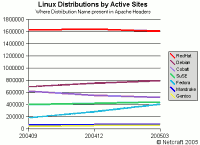Fedora Core 5 was released today. I started downloading it this morning, and it should be done this afternoon. I’ll probably start updating the Fedora boxes at work later this week, though for my home system I may wait until RPMForge catches up.
Meanwhile, I’m reading the release notes, and found one item particularly interesting:
There are new experimental drivers that provide support for the widely-used Broadcom 43xx wireless chipsets (http://bcm43xx.berlios.de/).

